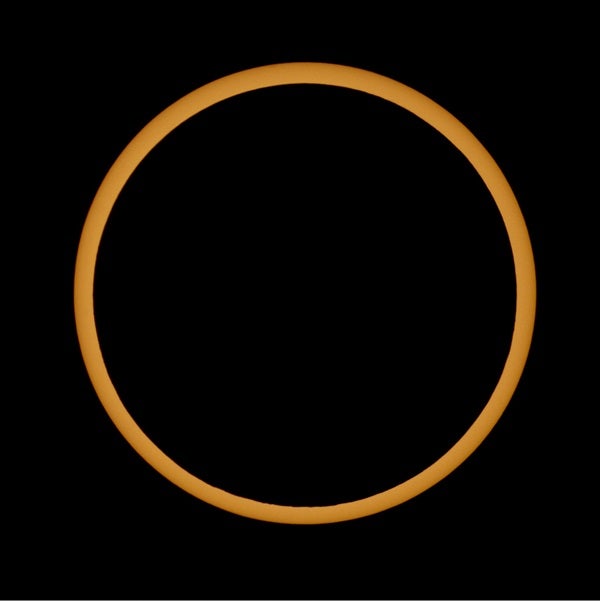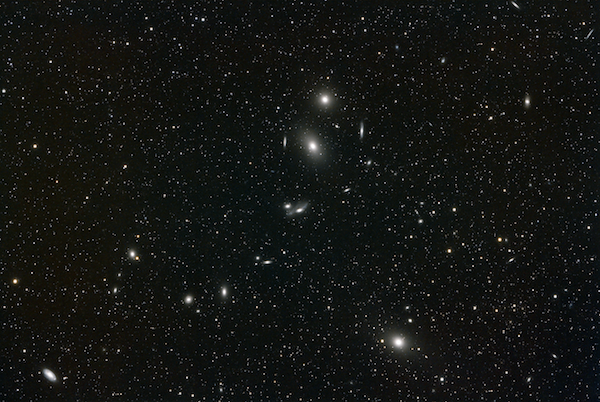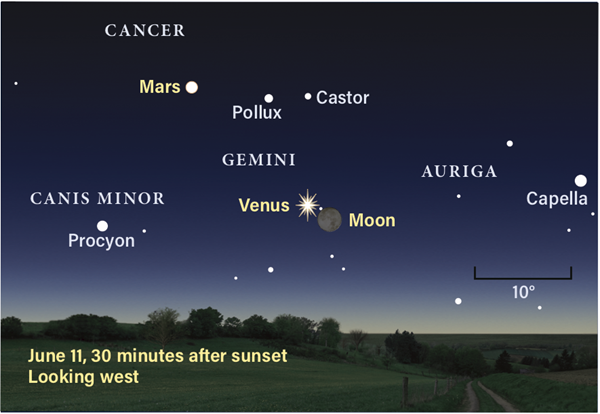Friday, June 4
Spring and summer bring longer days and shorter nights. But while the stars and planets spend less time in the sky, other phenomena get their chance to shine — sometimes literally.
Noctilucent or night-shining clouds appear to glow blue or white long after the Sun has set. These thin clouds form around 50 miles (80 kilometers) high — more than 10 times the altitude of everyday cirrus clouds — and are made of ice crystals wrapped around high-altitude dust in Earth’s atmosphere. Because they’re so high, they can catch the sunlight even after the Sun has set from a given location, thanks to the curvature of Earth.
These clouds are visible from latitudes between 55° and 70° north and are best seen at sunrise and sunset. Plus, they aren’t unique to Earth — they’ve been spotted by rovers on Mars, including in recent images snapped by NASA’s Curiosity rover.
Sunrise: 5:32 A.M.
Sunset: 8:25 P.M.
Moonrise: 2:47 A.M.
Moonset: 3:05 P.M.
Moon Phase: Waning crescent (27%)
*Times for sunrise, sunset, moonrise, and moonset are given in local time from 40° N 90° W. The Moon’s illumination is given at 12 P.M. local time from the same location.
Saturday, June 5
The constellation Virgo, now high in the southwest at sunset, hosts a smorgasbord of galaxies. That’s because in its direction sits the aptly named Virgo Supercluster. The cluster itself contains at least 100,000 galaxies; but tonight, we’re focusing in on just eight.
Known as Markarian’s Chain, these galaxies sit in the sky near magnitude 4.9 Rho (ρ) Virginis. NGC 4438 sits roughly in the center of the chain, so if you have a go-to scope and can plug in its name or coordinates (Right Ascension: 12h27m45.6s, Declination: 13°00’31”), you’ll align your sights right where you want them to be.
But because the Chain is so close to Rho — which is less than 5° to the galaxies’ southeast — you can simply star-hop (or, more aptly, galaxy-hop) to this formation. That’s because several bright Messier galaxies run between Rho and Markarian’s chain, serving as cosmic stepping stones. Just 1.5° north-northwest of Rho is M58. (M59 and M60 lie about 1.3° to M58’s east and slightly more directly north of Rho.) Another 1.5° northwest of M58 is M87 — a famous galaxy in its own right, with an equally famous black hole. Finally, another 1.3° northwest of M87 are M84 and M86. These two elliptical galaxies mark the western side of the Chain, which stretches northeast from this anchor point and contains — in addition to M84 and M87 — NGC 4435, NGC 4438, NGC 4458, NGC 4461, NGC 4473, and NGC 4477.
Sunrise: 5:32 A.M.
Sunset: 8:26 P.M.
Moonrise: 3:10 A.M.
Moonset: 4:04 P.M.
Moon Phase: Waning crescent (19%)
Sunday, June 6
Asteroid 3 Juno reaches opposition at 6 P.M. EDT. Located in the large constellation Ophiuchus, you’ll find it rising this evening in the southeast after sunset. Roughly magnitude 10, you should be able to catch the small world with large binoculars or a small scope, as it floats 5° west-northwest of magnitude 4.5 47 Ophiuchi. Juno falls in the top 10 largest asteroids, spanning about 145 miles (243 km) across. It was the third asteroid discovered, as indicated by its number, and was first identified in September 1804 by Karl Harding.
Once you’ve spotted Juno, it’s worth staying in the area to have a look around. Ophiuchus is a rich area and serves as home to several deep-sky objects, including seven Messier globulars sprinkled throughout the constellation: M9, M10, M12, M14, M19, M62, and M107.
Sunrise: 5:32 A.M.
Sunset: 8:26 P.M.
Moonrise: 3:33 A.M.
Moonset: 5:03 P.M.
Moon Phase: Waning crescent (12%)
Monday, June 7
The crescent Moon passes 2° south of Uranus at 2 A.M. EDT. You can’t see them at that time, but the pair is rising in the east about an hour before sunrise if you want to try your luck then. At that time, they’re about 3° apart, with the now 8-percent-lit Moon sitting directly below Uranus in Aries the Ram. Uranus shines a dim magnitude 5.9, which will require binoculars to see in the growing twilight. If you choose binoculars with a wide field of view, you should be able to get both objects at once. Uranus spans a mere 3″ across and will appear as a grayish, flat “star.” Another 11.5° above the planet (relative to the horizon) is Hamal, Aries’ 2nd-magnitude alpha star.
The Moon also reaches apogee — the farthest point in its egg-shaped orbit around Earth — at 10:27 P.M. EDT. At that time, our satellite will sit 252,418 miles (406,227 km) away.
Sunrise: 5:32 A.M.
Sunset: 8:27 P.M.
Moonrise: 3:57 A.M.
Moonset: 6:02 P.M.
Moon Phase: Waning crescent (7%)
Tuesday, June 8
Early risers can enjoy the giant planets Jupiter and Saturn, which rise by 1 A.M. local time and climb higher in the southeast in the few hours before sunrise. Saturn, located in Capricornus the Sea Goat, is magnitude 0.4 and located close to 4th-magnitude Theta (θ) Capricorni. Zoom in on the planet with a telescope and you’ll be treated to a stunning view of its ring system, which currently spans about 40″. Nearby float several of its moons, including Titan — the brightest, around magnitude 9, sitting southeast of the planet — and 10th-mangitude Dione, Rhea, and Tethys, which all cluster closer to the rings.
18.5° to Saturn’s east is bright Jupiter, shining at magnitude –2.4 in Aquarius. The larger, closer planet spans about 42″ in a telescope, nearly as large as Saturn appears with its rings. It is flanked this morning by all four Galilean moons: Ganymede floats alone to the planet’s west, while Io (closest in), Europa, and Callisto stretch to the east. In areas where Jupiter is observable by 2:11 A.M. EDT, the planet’s famous Great Red Spot will be crossing the central meridian at this time.
Sunrise: 5:31 A.M.
Sunset: 8:27 P.M.
Moonrise: 4:24 A.M.
Moonset: 7:02 P.M.
Moon Phase: Waning crescent (3%)
Wednesday, June 9
Asteroid 4 Vesta is currently sliding past a popular trio of galaxies known as the Leo Triplet. These three spirals — M65, M66, and NGC 3628 — lie between Theta and Iota (ι) Leonis and tonight, magnitude 7.5 Vesta is about 35′ to their southwest.
You can capture the 300-mile-wide (480 km) asteroid easily in most binoculars, and M66 is visible through 10x50s from the suburbs. The Triplet’s fainter components are more challenging, requiring at least 15×50 binoculars or a small scope. Any instrument or magnification that can fit a little more than a Full Moon (which spans about 30′) into its field of view will do.
The asteroid will remain in the Triplet’s neighborhood for another few days, so you can return to try again for the rest of the week if your views are hampered tonight or if you’re looking to spot the small world’s motion from night to night.
Sunrise: 5:31 A.M.
Sunset: 8:28 P.M.
Moonrise: 4:55 A.M.
Moonset: 8:02 P.M.
Moon Phase: Waning crescent (0.5%)
Thursday, June 10
New Moon occurs at 6:53 A.M. EDT. A little over two hours before that, however, marks the start of an annular solar eclipse, which first kicks off when the Moon’s penumbra, or outermost shadow, falls over Earth at 4:12 A.M. EDT. An annular solar eclipse occurs when the Moon covers the Sun from Earth’s perspective — but because the Moon’s orbit is not perfectly circular, the apparent size of the Moon with respect to the Sun changes depending on where our satellite is in its orbit. During an annular solar eclipse, a thin ring of the solar disk is still visible even during totality — this is often called the ring of fire.
Because some portion of the Sun will always be visible, even during maximum eclipse, anyone who wishes to view the eclipse must use eye protection such as approved solar filters or glasses. (This is unlike a total solar eclipse.) Don’t attempt to observe any portion of this eclipse without a filter!
This morning’s eclipse is visible only to those along a narrow path in Canada, Greenland, and Russia. The Sun will be low in the sky as annularity begins just seconds before 5:50 A.M. EDT, so an unhindered view of the horizon is needed. Annularity at the eclipse’s midpoint will last nearly 4 minutes and occur while the Sun is in the constellation Taurus. Once most of the Sun has been blotted out, bright Venus (magnitude –3.9) may be visible nearby, albeit quite low on the horizon as well. Annularity ends at 7:33 A.M. EDT and the partial eclipse ends at 9:11 A.M. EDT.
Mercury reaches inferior conjunction tonight at 9 P.M. EDT. The tiny planet is currently too faint to spot, but will become visible later this month.
Sunrise: 5:31 A.M.
Sunset: 8:28 P.M.
Moonrise: 5:32 A.M.
Moonset: 9:00 P.M.
Moon Phase: New
Friday, June 11
Venus appears low in the western sky at sunset, blazing a bright magnitude –3.9. It remains visible until nearly 10 P.M. Tonight, it’s sharing the constellation Gemini with a thin crescent Moon. The two hang less than 3° apart. Between them is 3rd-magnitude Mebsuta, an aging class G supergiant star that shines thousands of times brighter than the Sun, but whose surface temperature is much cooler.
Through a telescope, Venus appears about 11″ across and is nearly fully lit, showing a phase of 94 percent. That’s in stark contrast to the Moon, which is just over 2 percent lit by the time the pair disappears below the horizon. Binoculars will yield the best view, allowing you to more easily glimpse the thin crescent Moon against the darkening sky.
Sunrise: 5:31 A.M.
Sunset: 8:29 P.M.
Moonrise: 6:15 A.M.
Moonset: 9:55 P.M.
Moon Phase: Waxing crescent (1%)












